Well, hey. Remember me? It’s been a while, I know. But I’m back, with a new story.
Stevens Point, Wisconsin, is a city of 26,000 located in the center of the state. Its major exports are college graduates from the University of Wisconsin-Stevens Point, one of 13 public four-year Universities in the state, and beer from Point Brewery, which I’m partial to. A decent-sized paper mill and a few Insurance companies round out the economy here, among other businesses and services.
And, of course, the Stevens Point area once had a mall. Heck, there were even two in the area. Now they have none. Zero. Zilch. Nada. The big goose egg.
 The Stevens Point area’s first mall was located in suburban Plover, a smaller city located just south of Stevens Point, and it opened in 1984. I missed seeing this one, but the interweb seems to indicate it was very small and later became part of Rainbow Falls Water Park, which itself ultimately closed in the early 2000s. The mall was apparently demolished in 2003. It also seemed to have two names: Manufacturers Outlet Mall and Plover Mall. Anyone know anything about it? Any photos? All I could find were some back issues of a local paper with a few advertisements mentioning stores in the mall.
The Stevens Point area’s first mall was located in suburban Plover, a smaller city located just south of Stevens Point, and it opened in 1984. I missed seeing this one, but the interweb seems to indicate it was very small and later became part of Rainbow Falls Water Park, which itself ultimately closed in the early 2000s. The mall was apparently demolished in 2003. It also seemed to have two names: Manufacturers Outlet Mall and Plover Mall. Anyone know anything about it? Any photos? All I could find were some back issues of a local paper with a few advertisements mentioning stores in the mall.
Even before Plover Mall (or whatever it was called) appeared on the scene, a national mall developer (sources indicate Melvin Simon and Associates) had been interested in building a large-scale mall on the edge of Stevens Point, located near the interchange of US 10 and US 51 (later I-39). This proposal, introduced several years earlier in the late 1970s, was continually blocked by locals and ultimately lost steam as the years progressed. A few years later, a different developer came up with a different proposal – to build a regional mall in the middle of downtown Stevens Point. Several blocks of downtown Stevens Point would need to be razed for this development, but the developer marketed this under the careful guise of “urban renewal” because downtown Stevens Point was flagging, as were many cities’ downtowns nationwide. This proposal won the backing of locals because it meant their downtown, which had lost its luster in recent years, would once again be the vibrant, retail-dominant center they had known in the early and mid 20th century. Groundbreaking for this downtown mall, named CenterPoint Mall, took place in September 1984, and the mall’s grand opening took place in October 1985.
Anchored by two department stores, JCPenney and Green Bay-based ShopKo, with space for a third anchor, CenterPoint Mall opened with space for 60 smaller stores under one enclosed roof. The 220,000 square foot mall was never very successful, despite ample parking in the middle of downtown and only a few blocks from the University of Wisconsin – Stevens Point, a campus with over 10,000 students. The mall never filled to capacity, nor attracted the quality of stores present in larger regional malls such as Wausau Center, located just 30 minutes north of Stevens Point in Wausau.
Its decor was pretty standard for the mid-80s, with terrazzo-tiled floors, wood and brick layered storefronts, lengthy skylights, and many plants and trees poking out from sidewalk-style grates as well as from blocky wooden planters. At night, the mall really lit up with marquee-style rows of lighting along the skylights, giving its interior a dramatic, lively appearance. I sort of liked it, even though it was more than half dead for most of its existence. The layout of the mall was a simple dumbbell with a somewhat narrow main walkway. Pretty standard stuff for a city this size.
CenterPoint Mall was part of a larger trend and planning convention for urban renewal in cities across the country. The logic for the convention came from the fact that suburban-style malls had been enjoying incredible success in suburbs and the peripheries of cities, at the expense of downtowns, which had been the vibrant focal point of cities since their inception. Stores were rapidly leaving downtowns for these malls nationwide, and downtowns across the country were becoming outmoded derelict ghost towns. Beginning in the 1960s, and through at least the mid-1980s, developers had success convincing cities to tear up their aging, decrepit downtowns to put in typical regional malls. Many of these, especially in smaller cities, even had the same large, free parking lots shoppers enjoyed in the suburbs. Cities were quick to give up space to these developments, unfortunately tearing down many historic landmarks in the process. Ah, the prospect of progress, to make something old new again.
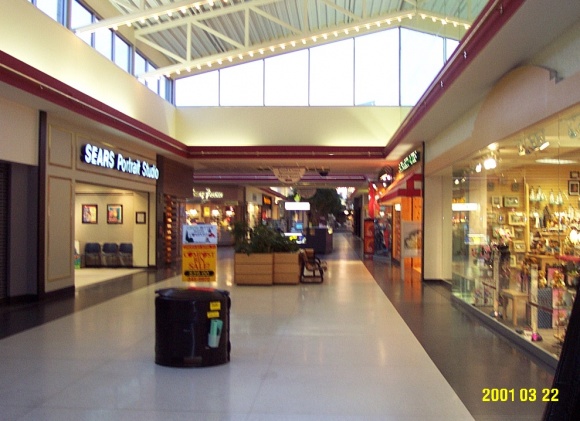 Examples of developments like these took place in Rochester, NY (Midtown Plaza), Salem, OR (Salem Center), White Plains, NY (several malls), Santa Maria, CA (Town Center), Milwaukee, WI (Grand Avenue Mall), Columbus, OH (City Center), and some even closer to Stevens Point in Oshkosh (Park Plaza Mall), Appleton (Avenue Mall), Wisconsin Rapids (Rapids Mall), and Wausau (Wausau Center). The list obviously goes on, and there are many more examples nationwide. The majority of these developments have struggled through the 1990s into the present, and many have been repurposed, are struggling, or have scaled back considerably. Interestingly, Wausau Center is an exception, having enjoyed success and helping to create a more vibrant downtown in the process.
Examples of developments like these took place in Rochester, NY (Midtown Plaza), Salem, OR (Salem Center), White Plains, NY (several malls), Santa Maria, CA (Town Center), Milwaukee, WI (Grand Avenue Mall), Columbus, OH (City Center), and some even closer to Stevens Point in Oshkosh (Park Plaza Mall), Appleton (Avenue Mall), Wisconsin Rapids (Rapids Mall), and Wausau (Wausau Center). The list obviously goes on, and there are many more examples nationwide. The majority of these developments have struggled through the 1990s into the present, and many have been repurposed, are struggling, or have scaled back considerably. Interestingly, Wausau Center is an exception, having enjoyed success and helping to create a more vibrant downtown in the process.
The dire implications of many of these developments result from improper positioning, pitting suburban interests against downtown constraints. The suburban model of retail cannot easily be superimposed on its predecessor (and arguably, its replacement as of late), the downtown. First, by the time many downtowns were repurposed to house traditional enclosed malls, there was already a sort of competition on the periphery of these cities. In Stevens Point’s case, several suburban-style retail clusters had already popped up on the north, east, and south sides of the city. The synergy of collective business, strip malls, and big box stores in these clusters helped them thrive, whereas there was no extra room downtown for these types of stores. While the mall had free parking, the rest of downtown was still constrained by on-street parking, and by tearing up several blocks of downtown to put in the mall there was even less of a reason to shop at the more traditional streetfront downtown stores.
This leads to the next point – ripping up a downtown grid to put in a huge mall is simply poor planning style. Several through-streets were truncated at the mall, creating a loss of flow through downtown. Areas directly north of the mall were suddenly completely cut off from downtown by the several block long development.
As the years went on, Pointers chose to shop at the businesses in the peripheral retail districts, or in nearby Wausau or Appleton rather than their own mall. As such, the mall was never fully occupied. More importantly, it was thus never able to attract the kind of destination stores to get people in the doors. There was never an American Eagle, Victoria’s Secret, Pottery Barn, or the like.
In the late 1990s, a small apparel-oriented department store, Stage, opened as CenterPoint Mall’s third anchor, on the north-facing side in the center. Unfortunately, Stage was short-lived, and closed after only two years, in 2000. In 2003, Dunham’s Sports opened in this space, but they too only lasted a few years, moving to the US 10 strip on the east side for a bigger store.
 Not long after, the mall began its long, slow spiral into oblivion. A visit in 2010 yielded a total of five stores open. In May of that year, JCPenney decided to call it quits and close their store, putting 39 folks out of work. That same year, the Central Wisconsin Children’s Museum departed as well. You know your mall is dead when a museum leaves…
Not long after, the mall began its long, slow spiral into oblivion. A visit in 2010 yielded a total of five stores open. In May of that year, JCPenney decided to call it quits and close their store, putting 39 folks out of work. That same year, the Central Wisconsin Children’s Museum departed as well. You know your mall is dead when a museum leaves…
Meanwhile, the mall had been in foreclosure, and the remaining handful of tenants began to trickle out. In May 2011, the city of Stevens Point declared the mall blighted and condemned it. This outraged Valley Bank of Iowa, who owned the mall in receivership, and they unsuccessfully sued the city to win back the mall. The city then scored a $750,000 federal block grant to redevelop the mall, and in March 2012, the doors to the mall were permanently closed to the public. ShopKo is the only store to remain, as its building is technically owned and operated as a separate entity.
I happened to stop by CenterPoint Mall one hot day in June 2012, and took the second set of photos that day. I was actually unaware the mall was closed to the public, as ShopKo was open and the entrance next to ShopKo was propped open with some activity. A maintenance man was doing something near the entrance, and a couple girls walked into the mall ahead of me, so I thought nothing of the fact that I shouldn’t have been there. This changed, however, when I saw that the many fig trees planted in the mall’s main walkway had lost most of their leaves onto the floor, creating a crunchy carpet of green and brown. I was able to walk the entire length of the mall unquestioned, as the two girls who walked in ahead of me went into a dead store that appeared to be some makeshift community center or charity or something. They hung out in the store talking and giggling, and I walked the length of the mall full of dead trees. It was a strange, eerie moment. I actually only discovered the mall was supposed to be shut when I got to the other end and saw notices on another set of entry doors that said the mall was permanently closed that March. Whoops.
In all, it was a satisfying but bittersweet visit. I got a chance to say goodbye to a mall I’d visited several times, and one I was always perplexed by. Demolition of CenterPoint Marketplace began in August 2012, and today most of the mall is history. Mid-State Technical College will move into a former portion of the mall in 2013, and ShopKo is open for business as usual. Third Street was extended through part of the former mall as it had been before the mall opened, almost exactly 27 years ago. What’s old is now new again, and as downtowns across the nation are experiencing a resurgence, Americans want denser, more urban developments and the organic well-designed community gathering space of a traditional downtown.
Elsewhere on the web:
- Flickr set of the mall from Andrew T. with useful commentary, from 2010
- A look back at CenterPoint Mall history, with many early photos, from the Stevens Point Journal
Photos from March 2001:
Photos from June 2012:


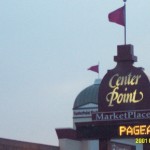
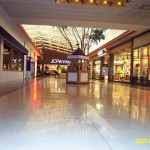
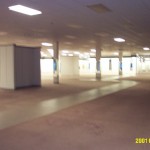
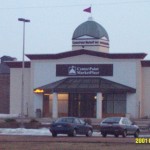
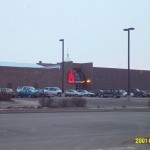
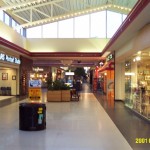
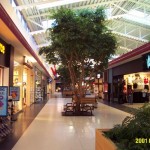
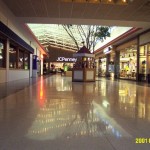
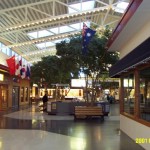
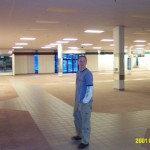
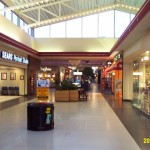
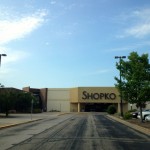
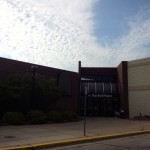
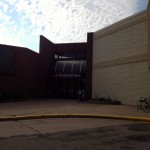
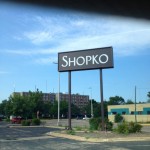

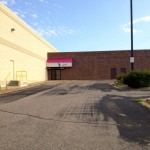

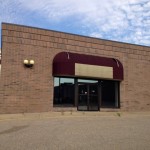
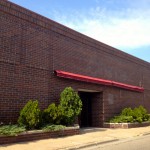
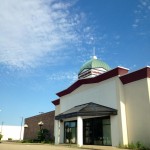
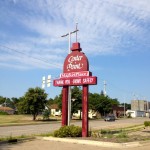
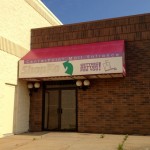
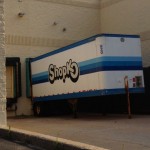
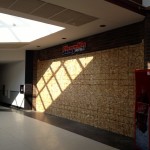
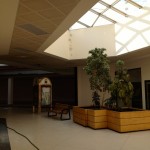
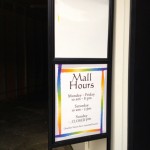
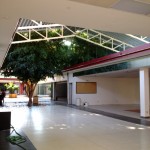
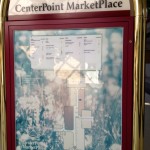
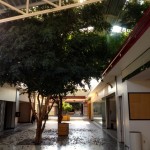
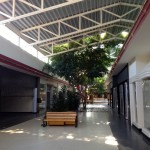
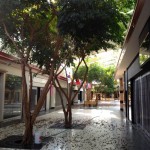
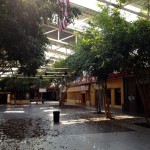
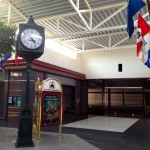
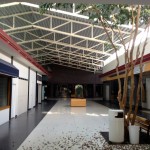
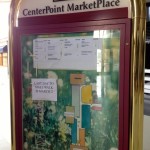
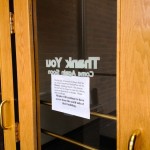
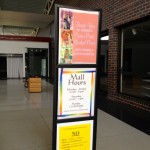
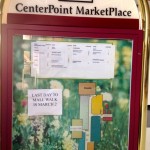

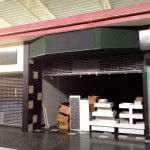
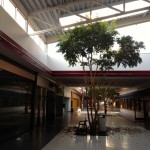
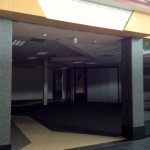
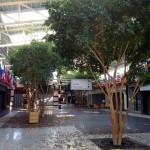
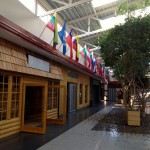
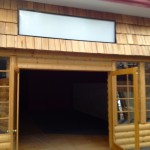
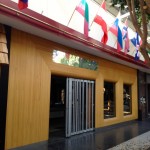
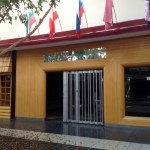
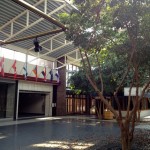
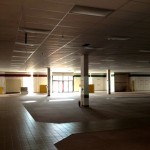
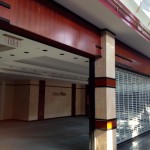
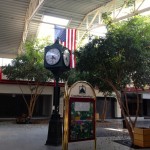
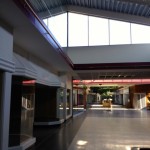
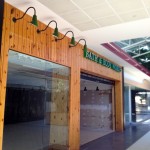
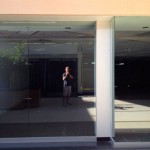
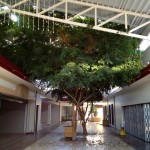
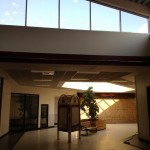
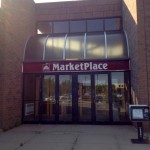
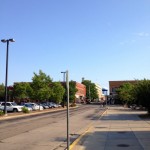
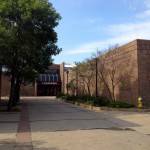
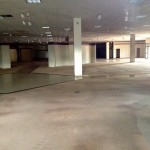
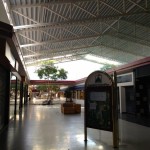
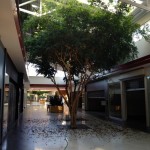
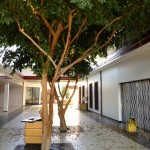
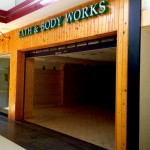
One of the storefronts was used by a trivia team in Stevens Point trivia contest hosted by 90FM, a college station. The contest lasted 54 hours.
I helped out a bit with the history in some of those images Andrew T. put up on Flickr (handle on there is ‘progrockfan28’). A lot of what I learned was through old clippings and archives from the 1970s / early 1980s. It was nice to see the local news at least give us a look into the past when it was announced that the mall would finally be done away with….this fate after a lengthy court battle between the city and the bank that foreclosed on the mall from its last owners, Dial Properties (they mismanaged this mall and were in the red with it, plain and simple, but I doubt even the big boys like Simon, GGP or CBL would have saved this mall). As you’ve pointed out, the original street grid as it was prior to 1984, is closely as possible, being restored, and ShopKo plans to stay put for now, being quite a popular store.
A mall on the city’s periphery ‘may’ have worked, but it would’ve needed to been done back in the mid/late 1970s when it was originally proposed. UWSP is one of the larger campuses in the state and as such, it would have drawn from the large student base that nearly doubles the city’s population when class is in session. Of course, we’ll never know this….we can only speculate.
Clearly though, the big box thing has worked well. Target and Fleet Farm are on US 10 east in the far outskirts of town, and the next two exits off I-39 lead to significant new developments that have taken shape over the last decade at the far SE side of town and just outside Plover. Mall tenants moved into a large strip mall in that village, and the other major development is a large shopping center anchored by Kohl’s, Walmart, and Best Buy. The city’s original retail strip, Division Street (the old US 51), is home to an old K-mart on the north end, and was home to a Copps department store and shopping center many years ago on the south side. That chain was actually headquartered in Point.
Centerpoint really didn’t have one big thriving period, but it was at or near 100% occupancy by early 1986. It only started to drain of tenants by the mid 1990s when US 10 was upgraded with bypasses around the various villages and City of Waupaca throughout the 1990s to make it easier and faster for folks from Point to get over to the Fox Cities and their behemoth Fox River Mall.
When “Mall” was changed to ‘Marketplace’ that year and Stage was tacked onto the mall’s former main entryway, it did have a ‘second wind’, with a modest boost in traffic and tenants, but obviously, all for naught.
I got out there that year on a rather overcast Friday evening in late June on my way home from a summer program at the tech college in Wausau. I only had a little over an hour to breeze through (got there at 7:30pm, and entered by that long narrow corridor adjacent to Shopko). Thankfully you’ve documented in your 2001 set just how it looked in the evening hours (albeit with the setting sun). While the design elements smack of 1980s glitz with all the marquee lights, it admittedly gave the mall a nice warmth to it in the evening hours, which was when I went in ’98. I’d say at that time, the mall was about 90% filled as well going by the directory I printed off the mall’s website at that time…..quite healthy, all things considered, and the ‘deadest’ area was actually the food court.
Good to see you still hanging around. Always nice to see these forgotten malls in my neck of the woods being highlighted.
“When “Mall” was changed to ‘Marketplace’ that year….”
“I got out there that year on a rather overcast Friday evening…….”
Clarification: When I meant ‘that year’, I meant 1998. Never got up to Point prior to then. My bad.
great to have you back again , we’ve missed your site !!
over in the UK we continue to ensure that retail stays in the city and town centres , with residential , leisure and restaurants and bars to keep the space used 24/7 …… big box food stores open 24/7 are common , but , again , they are moving back into the centre to keep our cities alive … it’s fascinating to read about the amount of ‘ dead and strugling malls in the good ol’e US ….. its difficult to see what they can be used for once thier retail lives have finished ?
keep up the good work on bringing us a slice of the US
Hey – I live in Wausau and our mall as you know had a lot of the stores this mall had. Yes our mall had 80’s decor till 2007. Yes I’ve been to the CenterPoint Marketplace around 2003 and around 2006. Can’t believe how many fewer stores were there in ’06 than there were in ’03. I feel bad that they tore this 27 year old mall down – especially knowing our mall is 30 years old and going strong. Our family goes to Stevens Point every once in a while!! 🙂 You didn’t think that CBL could’ve taken over our mall – I think they should’ve!!! I will absolutely miss going there—even if we’ve only been there twice. We tried going there in January 2012 but the ShopKo entrance was closed with bars. I could include A LIST of things that were both in our mall and theirs. KB Toys (KayBee) (both locations closed), Payless ShoeSource, Penney’s, Hallmark, Vanity, Maurice’s, Claire’s, Foot Locker (both locations closed) Bath & Body Works, The Buckle, Fred Meyer Jewelers (both locations closed), GNC, Tradehome Shoes, RadioShack (both locations closed) Roger’s and Holland’s (ours opened later [which is rare]) and Fanny Farmer. I know the Mall was relabeled to Marketplace in the Late 90’s. I’ve been to the Crossroads Commons, have been to every corporate store both in Stevens Point and Wausau, and have eaten at the restaurants we don’t have. I have to be honest with you: Your 2001 mall pics of the hallway TOTALLY remind me of our mall. I know the mall has NEVER been 100% full but when I saw the newspaper archives from 1985–1987 it sounded like it was 99% full. Some people claim it’s never been more than 75% occupied. I remember getting Hot Dogs in the Food Court. We have an outlet mall in Rothschild – The Cedar Creek Mall (Earlier Factory Stores and Transitioning?? Shopping Center) which had Discovery (later Kidz) Zone, Claire’s, KB Toy Outlet, OshKosh B’Gosh, Paper Factory, Famous Footwear, Kitchen Collection, Book Warehouse, Bass, Van Heusen, DressBarn, Casual Male Big and Tall, Rue21, Marcus Theatres and a grocery store called Pick ‘n Save (owned by Roundy’s – Just like Copps) 🙂 It had Steve and Barry’s in the 1st wing – but the company forced it to close—it was one of the last ones to close. They had a 35,000 sq ft addition once they converted the former Steve and Barry’s into what’s called the Patriot Center. As a result, they moved OshKosh B’Gosh but Famous Footwear volunteered to move to our mall in 2007. Rue21 moved in 2010. So there are differences between all three shopping centers. I love historical values of malls.
@Derrick:
GREATLY enjoyed wasting away the hours on weekends at the Wausau Center back in 1998 when I was in the area. That mall, I swear, was built in the late 1970s, what with how dark it was. The vaulted wood-beam ceilings, the colored illuminated glass at the end courts, and that large sunken seating area / fountain at Center Court. Then again, I’ve read often that we didn’t really get into ‘the ’80s’ until 1984, so that may be why mall design elements from the late 1970s still carried over into the early 1980s.
Wausau was also threatened with a large enclosed mall development in the 1970s. It’s why the U.S. 29 / 51 / Stewart Ave interchange was such a clustered mess until just a few years ago. They must have been prepping it back in the ’70s for such a development, only having it get shot down time and again. Eventually the developers agreed on the proposal to build it downtown. The rest is history.
All the Stewart Ave area got was a Kmart, the older Menards location (both demo’ed for the interchange’s complete overhaul…which was seriously needed), and the aforementioned (by you) Crossroads Court Shopping Center. Not sure when that came to be, but it had to be 1986-1987…..their ShopKo’s building design is the same as the one in West Bend WI, which is closer to me, and was built out when their newer Washington Mall was expanded and renamed to Paradise Mall.
While the two malls (Wausau Ctr. and Centerpoint) shared some chains, they also were different. Point had some of the newer names in some cat4gories. For example, Payless and Tradehome for shoe stores at Point, whilst Wausau had Kinney and Thom McAn, which were well-worn, trusted names in retailing. Also seemed like Centerpoint went more working-class market, where Wausau tried to go a slight bit more working-to-middle class. Wausau also aimed national chains for its food court (Diamond Daves Taco Co., Orange Julius, 1 Potato 2, and a full-blown McDonalds), where Point clearly went local (seen in those vintage 1985-1986 photos from the archives.)
I’m not sure when that outlet mall opened in Rothschild, but that was clearly what killed Plover’s outlet mall, mentioned in this article.
I know about all these facts!! I live here so that means I know. You just ask my mom!!!
I remember Diamond Dave’s, Orange Julius, 1 potato 2. And McDonald’s was moved to Forest St. in 2007. Now there’s Taco John’s, Stir Fry 88 and Subway. Have you been there since it was remodeled??
Cedar Creek Mall was built in 1991!! Ask my 2nd cousin about the mall and what was downtown before ’82.
You’re right about Crossroads Center.. ShopKo was built in ’88. Yes the Menard Plaza was built in the 70’s.
ShopKo Plaza in Rothschild was built in 1978. It has Goodwill (now Harbor Freight), Hallmark, Marathon Savings Bank (moved for drivethru), Book World, Nice as New (moved to Rib Mountain).
May I ask, did you live here at one time?? I’m proud to live in Central Wisconsin!!! If not, How do you know all this? YOU’RE AMAZING!!
Having been raised in Stevens Point, I can attest to the death spiral that was the last 15 years of the CenterPoint Mistake but, even until the early 90s, the mall was pretty full. The disposable income retailers left–Musicland/Sam Goody, Athlete’s Foot/Foot Locker, Kay-Bee Toys and the legendary Dave Koch Sports, to name a few–the rest was history. Stage cynically tried to play on the city, by only going into mid-sized cities where they thought they could scrimp on store design and product quality. And yes, there were plans to build something on the outskirts, which the downtown businesses railroaded. Allegedly, that effort ended up in Appleton as the Fox River Mall. I disagree with the 10 bypass contributing to its demise, the downtown is and always has been run by short-sighted good ol’ boys.
Wausau and Point are great contrasting examples of downtown retail experiments.
@Derrick,
I found out by mostly just asking around while I was in the area back in 1998, and then further reading online once newspapers and various archiving sites began to publish their archives online. I stayed up there for a month for a few summer courses up at Northcentral Tech. I’m quite amazed at myself that I still recalled all this info I took in over the years. I greatly appreciate backing up what I put forth.
Central Wisconsin’s retail history intrigued me at the time (still does). Just based on the fact that the residents in those communities of the region held fast for as long as possible in preventing enclosed mall development or re-doing their downtown districts to incorporate them to varying degrees of success (or demise like Centerpoint). I live in the Southeastern quadrant of the state near Fond du Lac. Take the entire Eastern half of the state into account, and we’ve had shopping centers and malls here that cropped up at the citys’ outskirts far earlier than the Central/North Central region. Oshkosh, Appleton, Green Bay and Milwaukee all have tried downtown malls. All failed over the years and have been converted since to other uses.
There are / were three other enclosed malls I know of in the Central WI region. Among them is a 3rd downtown re-development that was opened in 1977, the Rapids Mall in Wisconsin Rapids. The other two were malls on the outskirts of their respective cities….Northway Mall in Marshfield (open 1979), and ShopKo Mall in Wisconsin Rapids (open 1980).
Thanks for all the info so far.
@8rent,
Yeah, read about that in the news archives dating back to the mid-1970s. Simon Property Group (nee: Melvin Simon + Associates) were scouting this state after developing and opening the two malls in my region (Forest and Memorial Malls in Fond Du Lac and Sheboygan, respectively). They were turned down by your hometown and when they pitched to Appleton, they were hastily turned down as well. GGP took a gamble with the latter city after Simon bailed circa 1980, and it wound up in a nasty court battle between the city, the developer and the state DNR. This lasted some 3 1/2 years before Sears was given the green light to build out their “Store of the Future” prototype to replace their aging downtown Appleton store. The rest, once the court ruled in favor of GGP, is history.
Fox River Mall opened in August 1984 and has been a success ever since.
I’m curious where that Kay-Bee was in Centerpoint? I know some stores jumped around the mall over the years, mostly to move into larger space. For example, the separate Hallmark and Coach House stores were combined in 1997-98 to make a large ‘superstore’ between Bath & Body Works (seen in the 2001 set) and that large vacant space with the mirrored facade, which I’m not sure what it was. Little Professor Books didn’t last too long, quickly moving and becoming B. Dalton by the late 80s. Seiferts and ‘id’ Boutique, Fanny Farmer, and Uffenbeck (a jewelry chain based right in my hometown of Fond Du Lac..had 6 locations by the early ’90s) were also original tenants, as were Musicland, Vanity, GNC and Regis Hairstylists, Payless and Tradehome Shoes.
Heh, that’s about 1/3 of the tenant list I think.
I did spot that ‘legendary’ Dave Koch Sports you spoke of when I first visited Centerpoint in 1998. It was between Fanny Farmer and Payless Shoes. I also remember Figis (a mail-order/online catalog…or was…..are they still around?) having taken that large ‘junior anchor’ slot adjacent to ShopKo for a call center.
Was there ever any game room / arcade? I’d be surprised if there wasn’t. They were still fairly popular in the mid 1980s.
Trying to keep this as quick as possible: the Kay-Bee was right next to Tradehome Shoes, near the clock in the commons area. Little Professor Books actually is still in existence; they hung around for several years and moved out to the east part of town and are now Book Finders. B. Dalton never had anything to do with them. The Hallmark ‘superstore’ was bounced all over the mall before settling in a part of the mall that used to be the Sears appliance/lawn and garden outlet back in the mall’s brief heyday. The Hallmark was on Main St before closing, and CHG actually left Point before returning in that spot. Musicland (Sam Goody occupied the former Seifert’s space) and GNC were also later arrivals and not charter stores at the mall. Dave Koch Sports’ ‘legendary’ status is entirely tongue-in-cheek: overpriced and overrated, though they did host a lot of autograph events with Packers legends. (Proud owner of Nitschke and Ron Wolf autographs hosted by DK.)
Regis was the last retailer in the mall, finally moving out to the Crossroads Commons this year.
Figi’s is based out of Marshfield and is a massive global catalog operation. Their phone center is based off of Patch Street now on the east side of McDill Pond.
Other retailers who come to mind: Glacier Bay Gifts, Maurices, Golden Peacock, The Dahl House, The Book Garden, Rogers and Hollands, Fred Meyer Jewelers…
No, there was never a game room. The Plover Mall had one that was awesome, but that was the most awesome thing about that mistake of an outfit.
Hah! I was guessing that exact thing about Dave Koch, Brent…….overpriced.
Sounds to me like many tenants played musical chairs. Thanks for all the info. 🙂
@Matt from WI, sure thing! probably more energy than should have ever been expended on a mall that had more negative history for the community than positive.
Perhaps you are right in that regard. A full-blown entry and images of Centerpoint Mall is an over-done affair to showcase a mall that mostly took flack from the local residents for a host of reasons, be them economically (loss of businesses), politically (taxes and TIF districts), socially (loss of historic buildings, auto traffic patterns altered), or otherwise, but one positive that can be taken away is that it allows discussion and debate as to what went right and what went wrong. The two things I take as positives is that it kept downtown going for a bit longer than it probably would have. All that development out on U.S. 10 east off of I-39 though…..yeah, that dealt a bit ‘ouch’ to the mall anyways from which it couldn’t recover. The mall, even though having ample free parking, still wasn’t enough. I don’t think having the main drag being only one direction helped either. Rerouting U.S. 10 far north of town out in the sticks probably also sealed its fate too.
Appleton is much like Point in that its residents were vehemently against Fox River Mall’s development, as well as their (at the time) mayor’s brilliant decision to plop an upscale mall between the city’s large downtown department stores at the time, Gimbels and Pranges. Not only did those two stores eventually pull out which probably would have eroded other business, but the mall never leased to full occupancy, and Fox River Mall effectively put the final nail in the coffin anyways.
Repeat this scenario with Milwaukee, Oshkosh, and Green Bay as well, though in those examples and Centerpoint, all their downtown projects started fully leased, only starting to die out as the 1990s decade and the onslaught of discount and big-box formats took over.
I don’t think it’s only the harm to local businesses in downtown districts that are hurt by ‘both’ enclosed malls (whether outlying or as part of the downtown grid), AND discount stores that drives some folks batty. It’s also the sense in loss of the community fabric and history, never mind the street grid being forever ruined and unique buildings…some with historical merit, being razed in these ‘downtown revitalization’ projects that were so popular in the 1970s and ’80s. This, I can understand completely.
Even my hometown, Fond Du Lac, was mulling turning over a bunch of downtown properties over in the mid/late 1970s into an enclosed mall, wanting to stave off any further pullout of national chains. Penneys had already moved to the Forest Mall by this time, and Sears closed by 1977. Thankfully this didn’t happen, due mostly to intense negative pressure from local businesses and the general public. As such, we still retain many of the original buildings. Sure, Forest Mall and other outlying development took the national chains out of downtown which would have inevitably happened, but it still retains a strong local flavor with local stores, eateries and even a historic hotel still booking rooms, all housed within much of the original structures that have been around for 70-100 years. Some have been in business for several generations.
From what I’ve been following with this mall’s demolition and that of Port Plaza in Green Bay, as well as the complete overhaul of Park Plaza in Oshkosh turned over into a thriving office complex, it does seem like they’re at least going to do something with that land. Even if it’s just beautifying it. That alone is worth more than having a large building sitting there and rotting away. We have enough ‘Dixie Squares’ in this state as it is……one is plenty enough.
Plover Mall just seems to be one of those generic 1980s enclosed outlet malls that are almost extinct now: small, X-shaped floor plan, no anchors. The building looks to have been torn down before 2005.
1990 Directory of Major Malls lists a Sears at Centerpoint, which I’m sure was just a Dealer store.
@Bobby P.,
Yep, catalog store, closed in early 1993 when Sears ceased their print catalog division. While it closed, the portrait studio across the mallway you see in the 2001 set, did remain open through the early 2000s.
Enclosed outlet malls never clicked with people. I don’t count the Mills’ malls as ‘outlet malls’, because they now contain regular retailers and ‘destination’ stores for anchors, at least that’s been the case since Simon took over full management and ownership of the properties.
For the record, Wisconsin had several enclosed outlet malls. One of the first planned ‘outlet mall’ developments, if not ‘the’ first, was right here in Wisconsin with West Bend’s outlet mall located downtown (since been torn down for green space…it was last a furniture store). That same company would also wind up developing (in 4 phases), the Factory Outlet Centre outside Kenosha just off I-94, also since razed. I have pics of this both on film and digitally I’ll have to dig up someday. This was, at the time of opening, the largest outlet mall in the entire Upper Midwest, and drew massive crowds from my area and also Chicagoland until Gurnee Mills and the outdoor Outlet Shops of Pleasant Prairie were opened within a 2 year timeframe (1989-1991), effectively killing the already-dated Centre.
Actually the whole ‘outlet’ thing is kind of dead. When was an ‘outlet mall’ last built new? The last new one built out here in WI is located off the interstate (94) south of Watertown. That area is the major retail magnet now for the Watertown / Jefferson area. Even it has regular tenants in it you’d find in any big box or decently-sized mall in the country.
@Matt from WI,
One of the greatest examples of forgotten anchorless outlet malls is here in Arizona. Problem is it’s VERY obscure, so much so that when Labelscar came here, they missed this mall!
Power Square Mall in Mesa. Opened 1986: http://goo.gl/maps/kOA8n
The problems with Power Square are not so much its anchorless state rather than some location and position issues. If you go half a mile north of this mall, you run into Superstition Springs Center, a regional mall.
Also note the fact that the street corner has other businesses blocking a view of the mall coming southbound on Power Road. That’s a bigger problem because most people would get to this mall coming south off of US 60.
Not sure on occupancy. Does seem to have some businesses, but very low profile in the area. One of the more unconventional tenants is an “express library” of the City of Mesa. At least it’s still alive and surviving at some level.
I know this isn’t the same mall but today 12-11-12 there was a shooting at Clackamas Town Center; in Happy Valley; Oregon, so far reports show the gunman entered Macy’s apparel (there’s 2, one is a home store) and started shooting, at least one dead person but CNN had 3; the shooter plus 2 victims; apparently the shooter entered thru Macy’s wearing a ‘Friday the 13th’ mask and went into the fooc court so please pray for the victims!
Glad to see a new post. I missed you guys!
Oh, and to answer Matt from WI’s question: Actually the whole ‘outlet’ thing is kind of dead. When was an ‘outlet mall’ last built new?
Most likely in Grand Prairie, TX, this fall:
http://www.paragonoutletsgp.com/
@Kev, Wow, that must be a really underserved market. Not a single vacancy on the map.
The Premium Outlets in Cincy are pretty new too, I think. So it’s rare, but there have been a few recent outlet mall openings.
I’ll beat you: we got a Tanger Outlets here in the West Valley of Phoenix LAST MONTH (and another is on the way for the east side).
When that East Valley Tanger opens, I could see a death scenario for Arizona Mills in Tempe. Why?
Demographics.
It’s a straight shot west to South Phoenix in an area of central Tempe that’s not demographically perfect. Fairly black (that’s South Phoenix) and Hispanic. Due north of Guadalupe, a strange area that’s technically a Native American reservation, with the major streets overlaid in Spanish names I know friends that call it the “ghetto mall”.
At one point last year I went to AZ Mills to visit the JCPenney Outlet. I felt uncomfortable at the outlet due to the clientele, and then I spotted a dead Bennigan’s outparcel. I never even knew the chain had a presence in Arizona.
If outlet shoppers from outside these areas (west Chandler in particular) would have another…outlet for their shopping, it would probably begin the (at first slow) death spiral for AZ Mills.
@Raymie, I just saw this article in Retail Traffic on outlet malls in ST. Louis, I’ll post my thaughts at the bottom.
Simon, Taubman Bent on Building Competing Outlet Centers in St. Louis Region. Is Coexistence Possible?
Dec 20, 2012 11:15 AM, By Elaine Misonzhnik, Senior Associate Editor
It looks like in spite of earlier expectations, both Simon Property Group and Taubman Centers Inc. are going ahead with their outlet center projects in the St. Louis area. Industry sources say construction has gone too far in both cases for either party to abandon their site. However, the fact remains that the trade area could support only one traditional outlet center, making the stand-off that much more interesting.
Simon and Taubman announced their plans for outlet center developments in Chesterfield, Mo. in the spring of 2011. Simon’s St. Louis Premium Outlets was set to contain 350,000 sq. ft. of space and boasted Saks Fifth Avenue OFF 5th as an anchor tenant. Taubman’s Prestige Outlets Chesterfield was supposed to encompass 450,000 sq. ft., though at the time the firm would not reveal the names of the retailers that would occupy the center.
In recent months, both firms stepped up development activity. In November, Simon announced additional tenant commitments, including from Nike, Cole Haan, Converse, Gymboree and Adidas, and moved up its project’s opening date to August 22, 2013. Meanwhile, during Taubman’s third quarter conference call with analysts on Oct. 25, Robert Taubman revealed that Taubman has put up walls on about half the buildings at its center and has accelerated its opening date to August 2, 2013, ostensibly to coincide with Missouri’s back-to-school tax-free weekend.
In July, Taubman also announced the names of some of the tenants that will be taking space at Prestige Outlets Chesterfield, including the Gap brands and J. Crew Factory, Brooks Brothers Factory Store, 2b Bebe and Anne Fontaine, among others.
As of today, Taubman completed 100 percent of the work on the floors and the walls, as well as 90 percent of the work on the roof of its center’s first phase, set to contain approximately 80 tenants, according to Nicholai Schultz, director of development with Taubman.
“Retailer interest is extremely high,” Taubman told analysts. “There’s wide recognition that the market is superb and that our site is vastly superior.”
But while the greater St. Louis trade area might boast enough consumer power to support two new outlet centers in addition to the already existing St. Louis Outlet Mall in Hazelwood, Mo., Simon’s and Taubman’s projects are too close to each other for both of them to work, notes Rich Moore, a REIT analyst with RBC Capital Markets.
Even Robert Taubman admitted that given the competition for consumer dollars, return on investment on Prestige Outlets Chesterfield could be 100 basis points lower than Taubman previously expected. In July, Taubman estimated that the center would generate between $175 million and $200 million in sales.
Nevertheless, “Both projects certainly will open,” says Linda Humphers, editor-in-chief and director with Value Retail News, an industry publication.
The trick is that one of the players—most likely Taubman—might either try to attract different kinds of tenants to its property to avoid direct competition with Simon or sell the center to another operator who will convert it to a non-outlet use, Moore and Humpers speculate.
Alike, but Different
Given that Taubman specializes in more upscale malls than most big retail developers in the U.S., Moore notes that it’s conceivable Taubman executives have something different in mind for Chesterfield that a traditional outlet center. If Taubman would populate the property with luxury retailers along the lines of Tiffany & Co., it might still create a successful outlet venue even if Simon’s project is nearby, he says.
“I can’t imagine two [traditional] outlet centers right there,” says Moore, who lived in the area in the 1990s. “The only way it would work would be if the centers are different.”
That’s also a theory supported by David Stewart, vice president with real estate services firm Savills LLC, who notes that the reason Taubman is pressing ahead with the project is because outlet centers are the only viable development vehicle for the company at the moment. He suspects that both Taubman and Simon are currently holding negotiations with luxury retailers along the lines of Burberry and Prada to see who can land more upscale tenants.
“I don’t think either one is fully showing their hand right now,” he says.
Humphers offers a competing, but a somewhat like-minded theory. She notes that while St. Louis is an attractive market, it’s probably not big enough to support two outlet centers at once, a fact that both developers are savvy enough to understand. As a result, she suspects that one of the outlets might eventually be sold off and redeveloped into another retail venue.
While it’s certainly unusual for outlet center developers to get this competitive about a single project, Todd Lukasik, a REIT analyst with Morningstar, notes that both centers are small enough that even lower than expected returns wouldn’t have a significant impact on either company’s bottom line. That might explain why both Simon and Taubman are pressing ahead with their developments in spite of stacked odds.
“Taubman probably feels it has a higher likelihood of success than maybe is the view of some third-party advisors,” Lukasik notes. “They believe their site is a better site in that market. And the other thing is that these projects are generally [built] in first phase and future phases, and it maybe a situation where the company goes ahead with the first phase and then the second phase doesn’t get developed as quickly, or at all. Smaller projects might be more viable, even being so near.”
Thaughts…
The outlet mall is the in thing right now, just like the lifestyle center was hot a few years ago. As a result developers of all sizes are jumping into the game believing that their projects will be the ones prefered by the consumer. Only time will tell wich of these centers survive & wich get voted off the island.
In your case of Phoenix, Simon is competing with itself between it’s new center & the existing Mills mall that it owns in partnership with Taubman.
Arizona Mills is dying-declining for reasons that aren’t related to being an outlet mall. Any mall in that area would have the same demographic problems.
The only other outlet malls of any type besides AZ Mills or Tanger at Westgate are Power Square which is decidedly second-tier (read my comments) but still retains some of its original purpose, plus the Outlets at Anthem strip mall.
@SEAN, A lot of outlet malls are struggling. They’re no longer the bargain they once were and often include stores little different from regular mall locations and stores that sell merchandise that’s never on offer in regular mall-type stores. Better inventory control by chains and manufacturers of clsthing have really made it more difficult for outlet malls and offprice stores to have the desirable merchandise and pricing they once had.
@Rich, What most people don’t know regarding the outlets involve three things…
1. The original outlets were designed to basicly to get rid of last years product lines & were in industrial areas like Secaucus NJ.
2. In the 1980’s, the outlet mall was born & gave rise to such names as Mills & Tanger.
3. Today many brands have outlets to continue store expantion. Keep in mind that what is sold in the outlets MAY NOT be what is nessessarily sold in the triditional stores as lines are cut specificly just for the outlets & aren’t always of the same quality.
@SEAN, Outlets have a more complicated history. First there there were factory outlets and stores that sold goods from liquidators. The factory outlets were attached to factories back when we actually made stuff in the US and a few food processors still operate this way. The factory outlets sold seconds and last year’s stuff and were known mostly via word of mouth. The stores that sold liquidated stock (also seconds and leftovers from previous seasons) included pioneer discounters like S Klein, low end department stores like Raymond’s in Boston and the basement stores of lower middle brow chains like May or Macy. Some liquidators had a retail arm like Value City (part of Scottenstein, a liquidator). Department stores also sold liquidated stuff along with their own leftovers in periodic warehouse sales.
The warehouse sales and basements were phased out during the 70s. Chains like Raymond’s died in the 60s and 70s. S Klein lasted a bit longer and Value City soldiered-on but as less and less of an outlet. Around the time that basements died, some dept stores converted the space in a few of their locations into clearance centers that liquidated their old stock. May had some. Marshall Field’s had an enormous one in a sub-basement on State Street that lasted through the 80s. JCPenney has had them in various marginal old locations since about the 70s.
Outlets began to pop-up in one-off locations far from factories and in the beginnings of outlet malls from the late 70s–the one-offs and clusters mostly were in resort/daytrip areas or the fringes of metro areas where they wouldn’t compete directly with mall stores and traditional department stores. This period paralleled the emergence of off-price retailers—first Hit or Miss in the 70s, then TJ Maxx and Marshall’s–these appealed to people who wouldn’t shop a bargain basement or search for a factory outlet. and briefly, Marshall’s in particular, had something of a cult following. Sometimes outlets clustered in places like Chicago’s Maxwell Street area which had been a garment centter and a place famous for “fell off a truck” merchandise–those were small operations, not “brand name” operators; the Lower East Side of NYC had similar stores well into the 90s.
Some outlet malls were very successful, like the original “Mills”. Others, like the Belz-owned malls began to struggle fairly quickly. There was consolidation of mall ownership and the non-outlet stores and made for outlet mall merchandise began to creep-in during the mid-90s. Customers have gradually gotten wise, esp. as the non-closeout stuff and non-outlet stores started to crowd out the real thing. Outlet malls still get built, but many are barely holding on. I’ve been few in the last ten years that didn’t have a quite a few vacancies. The exceptions tend to be the Mills operations which have food courts, non-outlets, etc. and have evolved into retail destinations of their own.
@Rich, Wow, that was a fingerfull.
You basicly circled back to a question I’ve been wondering about for the last day or so… If the outlet malls are struggling as you point out, then why are more of them being constructed? Here in the NYC area we have Jersey Gardens, Bergen Town Center, Woodberry Commons & soon another giant outlet mall in Staten Island next to the ferry terminal. This latter project to me semes out of place since tourists are the market for this center & how many tourests are going to venture to Staten Island to visit an outlet mall with the same names as the other properties as every other outlet mall out there? I am taking the tourest traffic on the ferry into account here. Also there’s a 2% sales tax savings you get when you cross the Hudson.
@SEAN, Tourists were one of the original markets mostly because places like Myrtle Beach, et al., didn’t compete with big malls and people are assumed to spend more freely on vacation. They also went into boondocks locations off interestates that were accessible to more than one Metro area. there’s a cluster between ATL and Chattanooga. These were places that didn’t directly compete with malls. Given that the line between outlets and other stores has become blurred, it’s easier to build them in less marginal places, but rarely in direct competition with malls. A new outlet mall is being built with high end stores near National Harbor outside of DC, which is meant to be a resort facility and exists far from any successful mall. Judging from the St Louis article, developers think there’s a market not far from an existing mall. Given that the boom in conventional malls quickly oversaturated markets in the 80, I could imagine that developers are equally stupid about the market for outlet malls, although the redevelopment of old shopping centers with off price retailers (which has been common for years) creates something of a model for non-boondocks outlet retail. Conversion of struggling retail areas to outlets has come up from time time in established suburbs–it was discussed for the downtown of the suburb next to the one where I grew-up back in the late 80s, but never happened, probably because there were so many landowners.
Given that retail development has outstripped population and economic growth since the 70s, I can’t imagine new shopping developments on any relatively large scale succeeding unless they serve a high end demographic and/or cannibalize some existing mall nearby. Outlets of one sort or another have been a round for a long time and won’t go away but building more of them means that they will have to change further, perhaps into the equivalent of second string versions of name brand boutiques. That seems to be the Brook Brothers model.
@Rich, Good points. Let me add that National Harbor a massive project http://www.nationalharbor.com isn’t all that far from not one, but two massive Mills centers located in Hanover MD & Woodbridge VA. As you know the Baltimore/ DC area roughly contains 8-million residents, but has had far to many malls built to support either the current population or recent migration patterns & the site reflects this with numerous entries & comments.
Another retailer transitioning out of the outlet arena is Ann Taylor Loft. Loft stores have become a brand on to themselves & can be found in most upper tier malls
@Rich, Odly enough, Loft now has it’s own outlet at Dolphin Mall in Miami. Put another way, An outlet that was spawn from what was another outlet.
Who decided it was a great idea to put live trees in an enclosed space? 😐
@Matt from WI, In 1981, 2 friends and I got stranded at your lovely “mall.” We were in the 8th grade and had been invited to a stupid “camp encounter” for forestry. Anyway, thanks to fine cuisine of Wisconsin greasy spoon diners, my bowels loosened up in JC Penney. In short, since no one could or would direct me to a restroom, I thought it fitting to take a watery shit between two racks of women’s blouses. So much for cheese binding a person up. I’ll never, ever go back to Wisconsin again.
@Mark Wilson, Sounds like more of a personal problem with mall food rather than a problem with Wisconsin. How short sighted of you to hate an entire geographical area based on an upset stomach.
Of course, what should one expect from a person who willfully acknowledges using the restroom in the middle of a store.
Need a restroom? Try looking at the mall directory.
@Matt from WI, Stevens Point had 2 Shopko’s at one time. Copps on the south side was just a grocery store, and the Plaza just south (Across the parking lot) was a Shopko Plaza, I vaguely remember it just before it closed (I was about 3 or 4) i believe we where getting a VCR when we where there. Now just one sits downtown. On the east side was Target and Wal-Mart not Target and Fleet Farm. Fleet Farm original location was actually pretty much next door to Target then later moved further east in town after Stevens Point acquired land from neighboring townships. Starting East Towne Center, which now lacks a wal-mart but has a large hotel/convention center, and other places to shop, like Dunhams sports, furniture stores, and lots of little shops.